The following essay will appear in Climates: Architecture and the Planetary Imaginary, published this spring by the Avery Review and Lars Müller Publishers.
There is a strange sympathy between the atmospheric particles that float through the sky and the human beings who migrate across the ground and then across the sea. Each body sets the other into motion—a pattern of movement and countermovement. The particle bodies flow from north to south; the human bodies move from south to north. The difference in the kinds of bodies is apparent in the models used to grasp their character: on the one hand, there are the physical and chemical explanations used to model the climate system, and on the other hand there are the anthropological and psychological explanations used to model human character. Thus, the contact between human bodies and atmospheric bodies is the contact between these different kinds of models, the consequences of which are delineated in this story.
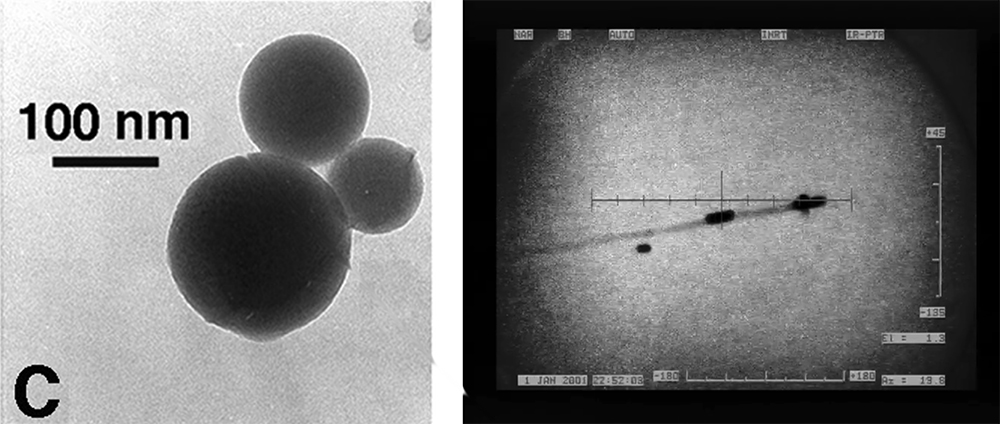
The global climate model is actually a series of submodels that are refined until they capture the causal structure of the climatic problem to be reproduced. In climate modeling, as in other forms of simulation, the trick is to somehow reproduce enough information to catch what is relevant in a problem—no more, no less. A working model of causality is really just a reliable explanation of a problem that has been formalized. In terms of scale, this form of modeling operates like a mesh, the apertures of which must be tuned to catch elements of just the right size. Do you calibrate it to catch the weather pattern, the cloud formation, or the water droplet? It depends on what you want to explain. Scale is what organizes this objective relationship between the problem and the model.
Histories of explanation and representation solidify around problems, meaning that we inherit conventions in knowledge production, perhaps none more important than the division of knowledge production itself into scalar categories. These categories emerge both as an objective reflection of the phenomena in question and the social, political, and economic decisions to orient scientific attention in one direction over another.
New kinds of problems—like climate change, for instance—pose special challenges insofar as they bring together the large and the small, the near and the far, the fast and the slow, the weak and the strong, making a mess of existing scalar conventions. The history of scale in climate science is an example. In the study of climate, signs must be extracted from a vast sea of scalar variability—this sea of cycles and oscillations span from a nanosecond quick flicker of infrared to the half-million-year passage of our astronomical seasons with all of the endless flux in between. Climate science has to extract individual rhythms from this cacophony. It has to work out what makes a rhythm, what makes it switch tempo, play more insistently, with more syncopation or just plain out of time.
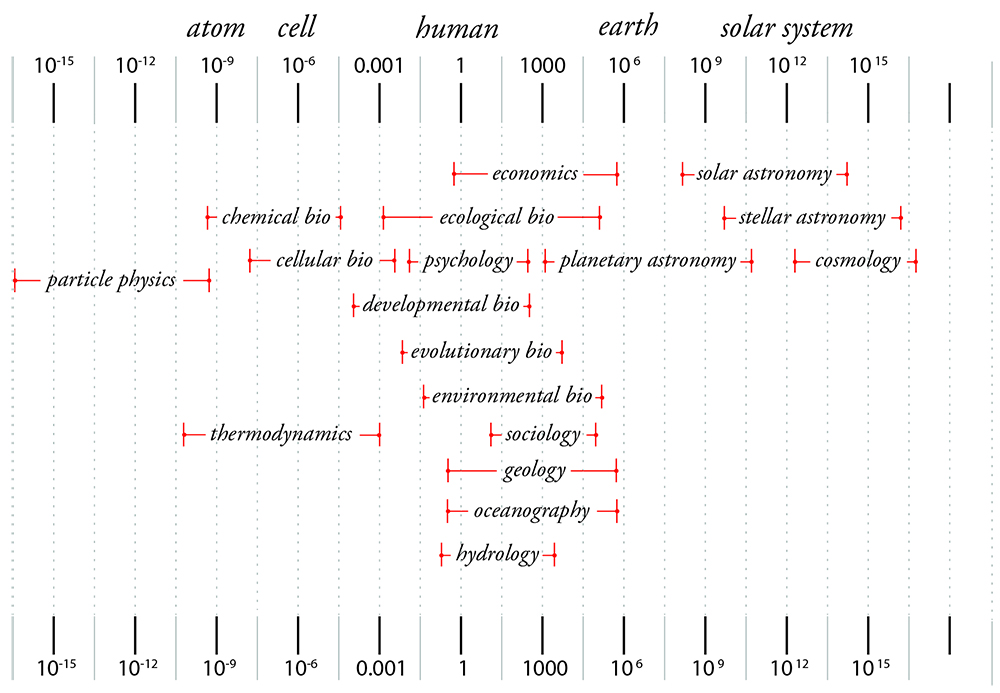
Scientists obviously set out to explain a wide range of problems through climate models. Even if the ground of verification differs, we find something similar when we look at models of human subjectivity. Here, the aim has always been to use the signs of external conduct to construct a model of internal motivation, to understand the way that conduct emerges out of natural dispositions—or, as Michael Feher has beautifully put it, according to a schema of conflict between good and bad propensities, such as charity and greed, passion and reason, shame and self-worth. Models of subjectivity are supposed to explain what causes human beings to behave the way they do. What happens, then, when environmental models intercept models of human character? How do social modeling and scientific modeling inflect each other? Examining changes across a band of arid land in central Africa may help to demonstrate the inextricability of social and scientific modeling, and the consequences of this encounter.
“Desertification” refers to the process by which arable land becomes unproductive, usually as a result of poor land management. For scientists like Jule Gregory Charney, the term became a kind of conceptual paradigm through which to understand the case of the Sahel and the severe drought that beset the region in the 1970s and 1980s. Essentially, what later became known as the Charney Hypothesis claimed that indigenous mismanagement of land was leading to a loss of soil and vegetation, and, more importantly, that this loss was changing the reflectivity of the earth’s surface, resulting in less rain. The account took hold of the Western scientific imagination; in their view the people of the Sahel had become weather-makers of the most self-destructive kind.
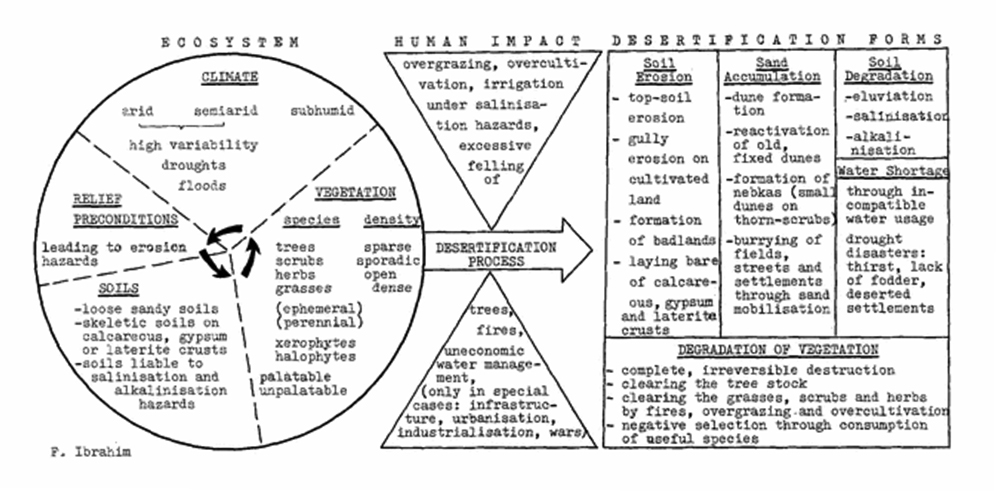
The two kinds of models described above can be used to understand this account. First there is a generalizing and reductive explanation that attributes land degradation to the people’s character. The literature from the period refers to the farmers’ inability to reason, to plan, to calculate properly—that is, to their irrationality—but also to their inflexibility, to a lack of capacity to adapt their actions to changing circumstances. The other model of explanation involves the behavior of the environment in response to their actions: the irreversible damage to the earth’s surface triggered positive feedback in the atmosphere, which then caused drought. The intersection of these two models gives us a specific geopolitical paradigm: man-made desertification. The consequence of this paradigm was a disastrous legacy of ill-conceived aid packages, reforms, and interventions.
In the last decade, however, climate science has finally confirmed a saying of the Zaghawa people in Chad: The world dies from the north. The severity of the Sahelian drought made it a perfect object to train generations of climate models upon. What climate scientists finally deduced—counter to the prevailing narratives—was that the oceans were driving the drying of the Sahel. The first clue in this detective story was a set of models that correlated ocean temperature to precipitation, indicating that the heat in the ocean was acting like a pacemaker for the monsoon.
However, the relationship between heat and rain was still only part of the picture—something was missing. The models could reproduce the signal, but not its strength. Something else was driving the ocean temperature. Was it global warming? Answering this question was complex. What scientists found was that drying depended on a balance between two forces. The first was the temperature difference between cold and warm water in the tropics; the second was the temperature of the troposphere. Instability in the first would tend to more rain, while stability in the second would tend to more drying. The victor would drive precipitation patterns.
The balance of power was poised until an unlikely protagonist tipped the scales. As if in homage to Lucretius, fate would be decided by the infinitesimal swerve of a particle. Most people associate global warming with carbon dioxide. But fossil fuels produce another byproduct: aerosols. For some time science has been aware that European and American aerosol emissions were changing the temperature of the oceans. Scientists hypothesized that this was weakening the temperature gradient that was so crucial to precipitation patterns. Aerosol particles are unlike carbon dioxide in that carbon dioxide is long-lived and disperses evenly, which is why we can talk about parts per million as a global concentration. Aerosol particles are short-lived. They get lifted up in air currents, carried through the atmosphere, and then deposited. Their effects, therefore, are far more localized. Unlike carbon dioxide molecules, which are identical, every single aerosol particle is individual.
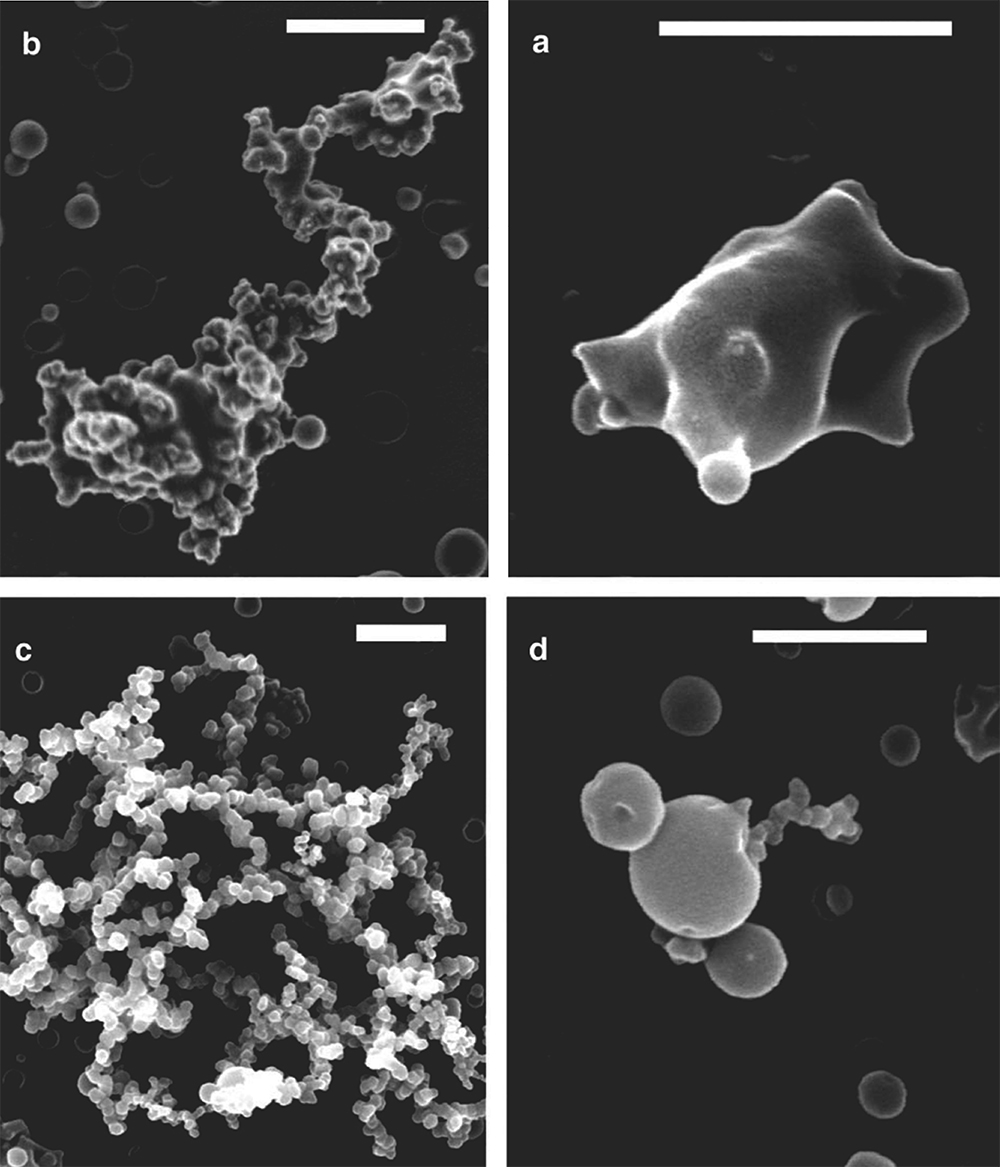
This character is what makes them so intractable scientifically but also so revealing politically. Individuality is what allows science to identify the source of the particle. Like a fingerprint on a crime scene or a tracing in an atmospheric bloodstream, aerosols tell us a great deal about the structure of the great aerial oceans and the way that their currents redistribute the consequences of human and nonhuman actions. For example, aerosol deposition in the Amazon tells us that, astonishingly, a small, dried-out lake bed named Bodélé in Chad has been secretly supplying the rainforest with nutrients for years. Saharan dust carried dozens of kilometers over the Atlantic has been fertilizing an Amazonian garden. In the case of the Sahel, it does something less metaphysically but more politically suggestive.
Is aerosol dispersion caused by European and North American industrialization significantly contributing to a drying in the Sahel? We don’t really know. But the question itself is an unusual one, and its unusualness reveals blind spots in the way climate change is thought of and discussed. It’s not, “What is the acceptable average temperature?” It’s not, “What is the global concentration of carbon dioxide?” It’s not a we-are-in-it-together kind of question, because it’s not posed at the scale of the planet or the globe. It suggests that actions in one limited part of the world affect actions in another limited part of the world, even over great distances. It’s a different kind of question because it’s posed at the scale of specific people and their fate, which is the scale of lived histories, not their negation into a universal humanity. And therefore it’s a paradigm of a differently scaled politics.
Interestingly, as the model of the environment changed, so did the models used to understand human behavior. The first shift was to recognize the incredible cultural and linguistic diversity of the region. The second was to recognize the diversity of forms of life: For example, conceiving of a gradient of sedentary and nomadic life where East to West differences yielded similar territorial practices, but different clans and North to South differences yielded both different territorial practices and ethnic groups. As Alex de Waal has shown in his account of famine in Darfur Sudan, looking at the same socioecological diagram from the perspective of the herders, one sees a checkerboard of new nomadic opportunism, in which pastoral routes are used to avoid farms.1 These models rely on an understanding that what we sometimes take as an essentialist ethnic marker is usually a marker of activity: i.e., you can be an Arab by being a nomadic pastoralist. Indeed there is a certain pragmatic fluidity but also a precarious tension between these livelihoods that is exacerbated under environmental duress. Finally, these models are informed by an awareness of indigenous environmental concepts: for example, the absence of statistical forms of reasoning about precipitation, and in their place something more like a qualitative rather than a quantitative model. Together these factors radically invert the previous concept of the Sahelian farmer plagued by irrationalities and a kind of stubborn ancient inflexibility, instead offering an opposite notion in which the autonomy and flexibility of indigenous farmers and the intelligence of their land use strategies has come to be acknowledged, albeit in a context of extreme global environmental stress. While using these different models in concert has produced a more nuanced and accurate understanding of the social and climatic changes in the region, it does not alter the fact that the Sahel remains caught in a situation not of its own making. Social stress is still being exacerbated by nonlocal environmental factors, and a great diasporic movement of people is still heading to the major cities on the West African coast and north toward Europe and the Mediterranean.
The southward trajectory of aerosols and their effect on the climate of the Sahel and the northward trajectory of migrants attempting to flee sub-Saharan Africa and enter Europe aligns in a pernicious geometry. What gets emitted as a particle returns as a refugee; what is received as a refugee gets returned as a particle. Movement and countermovement. In this drama, Edmond Locard’s principle that every contact leaves its trace, the very cornerstone of modern forensics, still applies, but with a complicated catch. The contact and the trace drift apart. Environments loosen the bonds between cause and effect, obscuring the link between attribution, responsibility, and—potentially—justice.
What, then, does “justice” mean here? During the 2009 Copenhagen Climate Conference, the public debate was framed by two simple questions: Would an accord be signed or not? And what would be an acceptable average temperature increase? Would it be 1.5 degrees, 2 degrees, or 2.5 degrees? Unbeknownst to the G77 group of developing nations, the Danish had been circulating a secret text exclusively among the G20 that proposed a 2-degree global average temperature increase. When it was discovered, the Sudanese diplomat representing the G77, Lumumba Di-Aping, called an impromptu press conference, saying “We’ve been asked to sign a suicide pact.” He called it the colonization of the sky, and finally declared it “climate genocide.” The proposed average of 2 degrees meant 3.5 degrees in many of the nations that Di-Aping represented, which would be a catastrophic result for sub-Saharan Africa. Di-Aping’s claim was an attempt to reestablish the proper political scale within a debate about temperature increase in order to prevent specific populations from being effaced by the coarseness of the model.
The conference was a failure. What it revealed, however, was a certain calculus of life and death concealed in every model. If images belong to a kind of evidentiary paradigm and a symptomatology of signs, then perhaps models belong to a speculative paradigm, a kind of etiology of causes. The model is an observation and a hypothesis. It’s both the data that constitutes it and a claim made from that data. But insofar as the model is the means by which scenarios can become rehearsed, it’s more than a representation of possible futures. They become a medium through which the present produces the future, though somewhat speculatively.
The Conference of Parties (COP) framework sits at the summit of a vast collective scientific endeavor, but the evidentiary paradigm that forms its foundation presupposes too much. First, it assumes a good faith in the forum and in the way political change flows from understanding. It also presupposes a common regime of intelligibility—shared stakes, institutions, and protocols. In other words, it presupposes so much of what the world lacks. So where does this leave architecture and design? The way that models of the environment intercept models of human subjectivity is a crucial area of inquiry, and one in which architecture and design can intervene. We need to find a way to think of these two things—environment and subjectivity—together, but in light of the failures of COP 15 and the more recent, but nonetheless extremely limited, agreements borne of COP 21, can we imagine an intersection that doesn’t presuppose as much faith in the functioning of the forum? That doesn’t presuppose a common regime of intelligibility but instead starts with a proposition that embodies the asymmetry of the situation?
The anthropologist Alfred Gell proposes a thought experiment that might offer a useful way of answering this question and, importantly for us, for understanding the role of design within this paradigm. It involves two figures: the hunter and the trapper. Evidence always requires an interlocutor, and the hunter, who is sensitized to science, stands in for this evidentiary regime, for, in a sense, discursive power. Science also requires a figure able to reconstruct a spatial and historical explanation from a series, so the hunter is the first to narrate an event. (Of course Nimrod, the biblical figure of the hunter, as we know, is responsible for the Tower of Babel.) Finally this narration requires a forum—like a book or a conference—in which the story can be retold. The power of the hunter is an explanatory power, grounded in the interpretation of signs within a space of shared intelligibility. This is the paradigm through which climate science has primarily been pursued.
The second figure is the trapper. Gell’s text on “Vogel’s Net” is really an extended thought experiment in which he mounts an imaginary exhibition of animal traps. Traps embody what I want to call an asymmetry of intelligibility. At the very least, the trap is an object that works best when it is unintelligible to its subject. At most, the trap embodies something absolutely essential, which is a kind of fundamental inequality between beings. To work well, the predator must understand the behavior of the prey. The most successful trapper is the one who is closest to the animal itself—the trapper who grasps the behavior or the prey in all the dimensions of its character and makes a device that embodies the concept of its character.
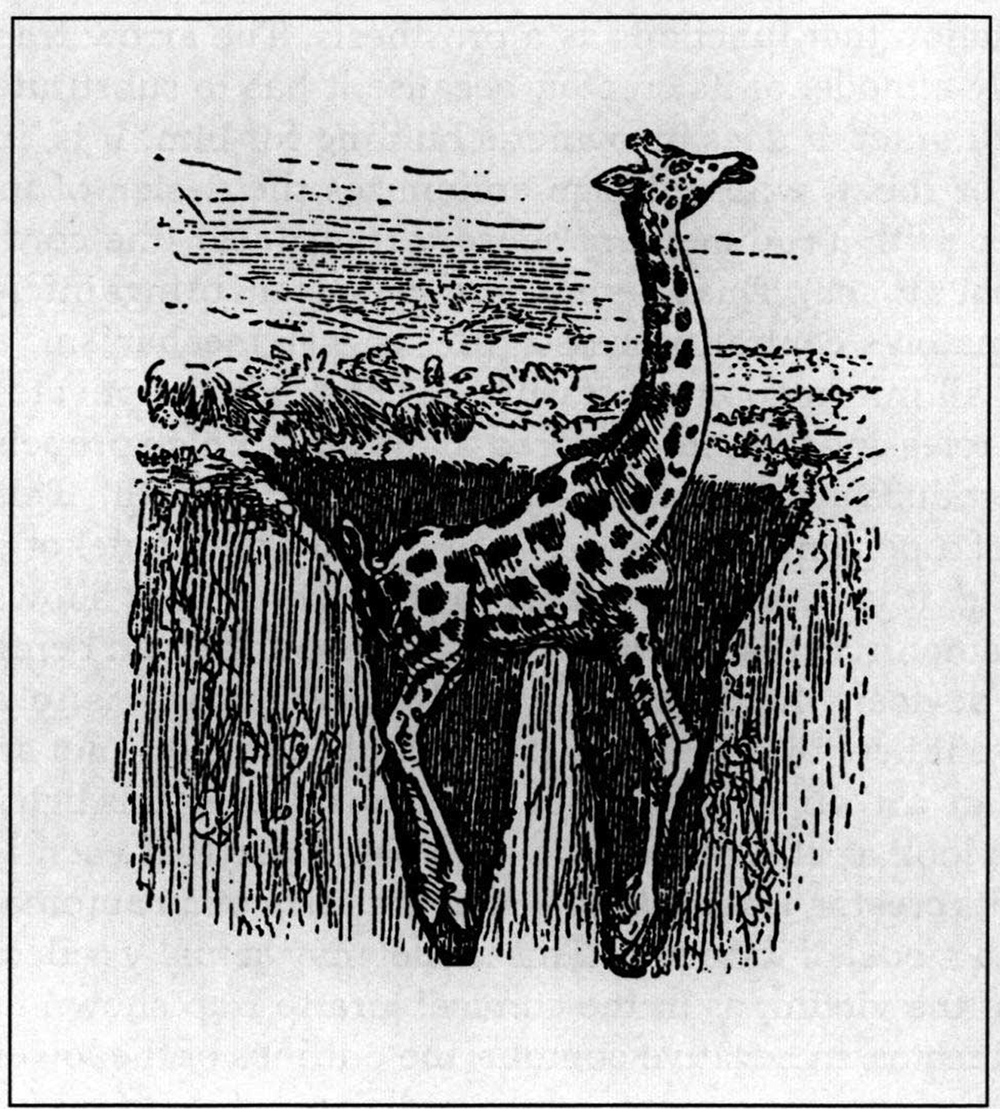
The trap rarely embodies the form of the prey, though sometimes it does, as in the humorous giraffe trap. More often, it embodies something essential in the prey’s character, such as the propensity of the rat to burrow. The trap expresses the ambition of the predator to catch the prey. Therefore, the trap is a designed object in which the character of the prey intersects with the intention of the predator. The chimpanzee trap, for example, solicits the natural curiosity and intelligence of primates. “The thread is very thin and the chimpanzee thinks it can get away,” recalls a member of Cameroon’s Fang community, Ze. “Instead of breaking the thread, instead of pulling the thread, it pulls on it very gently to see what will happen then. At that moment the bundle with the poisoned arrow falls down on it, because it has not run away like a stupid animal, like an antelope would.”2 The trap preys on the primate’s ability to balance its instinct with its intelligence. A small thread captures something essential in the character of its subject, better than an image.
The animal trap turns the personality of the animal against it. This is why Gell is right to think that traps always have a tragic dimension. If we train ourselves to look at architectural and environmental traps, we might be able to extract a portrait of the character of the prey or, more precisely, a portrait of the point of intersection at which the character of the prey and the intention of the predator meet. In architecture, power never touches the human directly. It addresses the human through the life world in which the human subject exists as a set of alternative, conflicting potentials. Environmental determinism would suggest a direct correspondence between climate or geography and the character of the human being, as if an unbroken line of causality chained the human character to the strength of the sun.3 But in environments, we never find lines of causality without fields of uncertainty. This uncertainty is not only what tempers the strength of our predictions or what qualifies the veracity of our claims. It is the terrain of political struggle itself. Architecture’s role in this struggle might be to contribute a particularly uncertain kind of trap, lacking in virtue and good faith, patient, malevolent, living and residing in our blind spots, the amoral, anti-Enlightenment object par excellence.
-
Alex de Waal, “Sudan, the Sahel, the Sahara: the 99 Percent Principle,” Les Dossiers du CERI 3 (Summer 2001), 9. ↩
-
Pascal Boyer, Barricades mysterieuses & pieges a pensee: Introduction a l’analyse des epopees fang (Nanterre, France: Societe d’ethnologie, 1988), referenced in Alfred Gell, “Vogel’s Net: Traps as Artworks and Artworks as Traps,” Journal of Material Culture, vol. 1, no. 1 (March 1996): 15–38. ↩
-
Vitruvius, for instance writes, “Though, however, the southern nations are quick in understanding, and sagacious in council, yet in point of valor they are inferior, for the sun absorbs their animal spirits.”Joseph Gwilt trans., The Architecture of Marcus Vitruvius Pollio in Ten Books (London: Priestley and Weale, 1836), 168. ↩
Adrian Lahoud is dean at the School of Architecture, Royal College of Art London.

